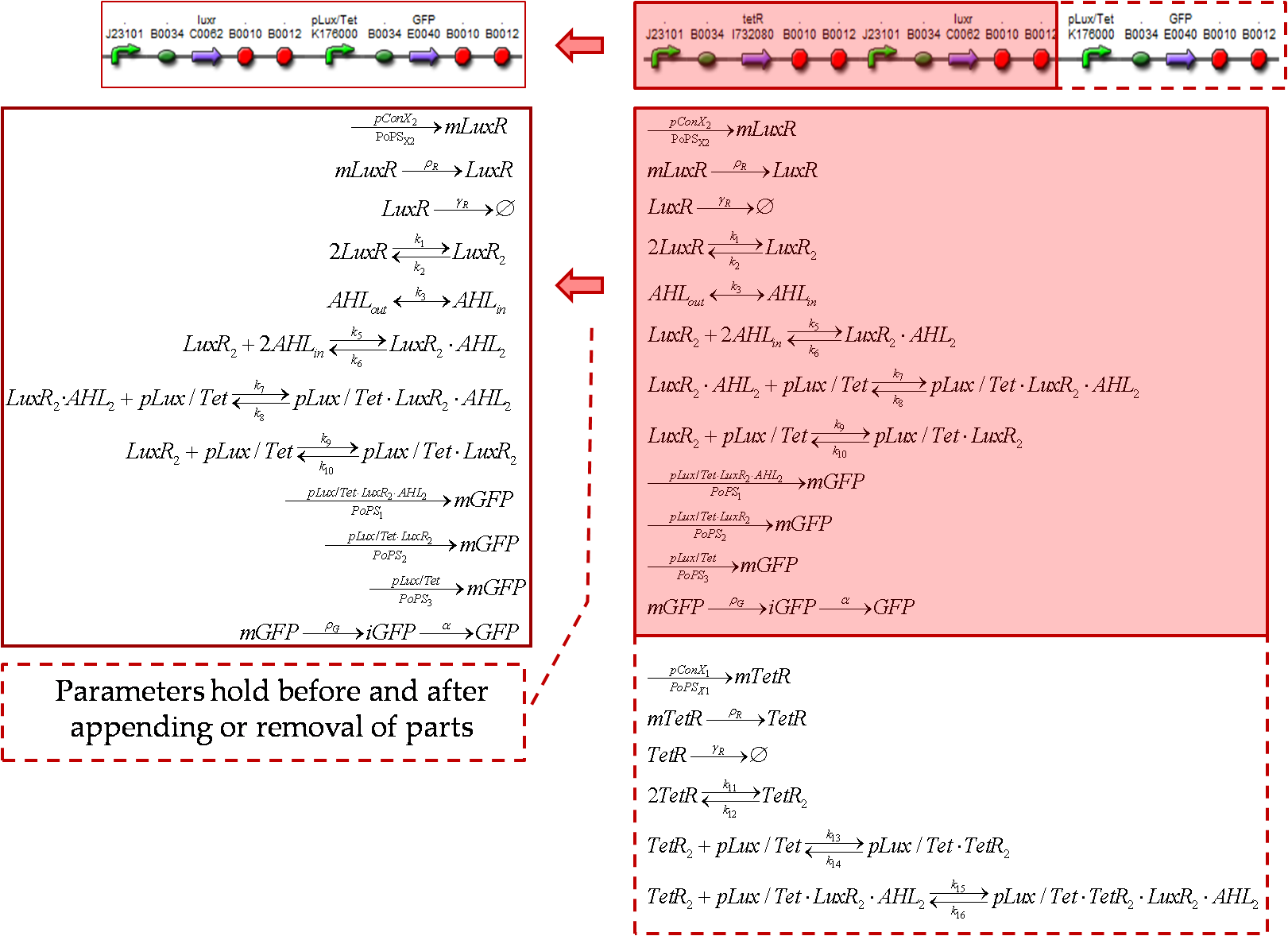Team:USTC Software/Standard
From 2009.igem.org
(→Robustness Analysis) |
|||
| Line 1: | Line 1: | ||
| - | |||
| - | |||
| - | |||
| - | |||
| - | |||
| - | |||
| - | |||
| - | |||
| - | |||
| - | |||
| - | |||
| - | |||
| - | |||
| - | |||
| - | |||
| - | |||
| - | |||
==Kinetic Parameters Identification== | ==Kinetic Parameters Identification== | ||
First of all, we shall clarify that, being dedicated to dry lab experiments, we naturally doesn't have as many incarnated Bio-Parts as usual wet labs do. | First of all, we shall clarify that, being dedicated to dry lab experiments, we naturally doesn't have as many incarnated Bio-Parts as usual wet labs do. | ||
| - | In wet lab experiment, kinetic parameters are notorious for their difficulties to | + | In wet lab experiment, kinetic parameters are notorious for their difficulties to be obtained quantitatively. To construct a well fabricated device, the kinetic parameters are crucial for an extensible part. When certain parts are placed in the network, certain biochemical reactions with holding kinetic parameters are introduced. To identify kinetic parameters of basic devices determines the extensibility of devices. |
| + | |||
| + | [https://2009.igem.org/Team:USTC/Modeling/Model-2 Model 2]<partinfo>K176126 DeepComponents</partinfo> is a subsystem of [https://2009.igem.org/Team:USTC/Modeling/Model-3 Model 3]<partinfo>K176066 DeepComponents</partinfo>. | ||
[[Image:wet2dry.png|center|500px|thumb|[https://2009.igem.org/Team:USTC/Modeling/Model-2 Model 2] and [https://2009.igem.org/Team:USTC/Modeling/Model-3 Model 3] from [https://2009.igem.org/Team:USTC/Modeling 2009 USTC Wet Team]]] | [[Image:wet2dry.png|center|500px|thumb|[https://2009.igem.org/Team:USTC/Modeling/Model-2 Model 2] and [https://2009.igem.org/Team:USTC/Modeling/Model-3 Model 3] from [https://2009.igem.org/Team:USTC/Modeling 2009 USTC Wet Team]]] | ||
| - | + | Here we put forward another feasible way to define dynamic parameters of biochemical reactions, and further characterization of single biobrick and combined bio-devices, in terms of chemical dynamics view. | |
| - | + | ||
| - | + | ||
| - | + | ||
| - | + | ||
| - | + | ||
| - | + | ||
| - | + | ||
| - | + | ||
| - | + | ||
| - | + | Data Sheet and Related Construction. | |
| - | + | # A pool of standard reactions should be constructed according to following suggested rules. | |
| - | + | ## Clear characterazation of reacting substances, grouped by reactants and products. | |
| - | + | ### substance's general physical properties, including molecular mass, phase diagram, infrared spectra, etc. | |
| - | + | ### substance's general chemical properties, including chemical composition, hydrolysis constant, ionization constant, and the stability in conventional intermediate like air and distilled water, etc. | |
| + | ### '''''' | ||
Revision as of 15:27, 21 October 2009
Kinetic Parameters Identification
First of all, we shall clarify that, being dedicated to dry lab experiments, we naturally doesn't have as many incarnated Bio-Parts as usual wet labs do.
In wet lab experiment, kinetic parameters are notorious for their difficulties to be obtained quantitatively. To construct a well fabricated device, the kinetic parameters are crucial for an extensible part. When certain parts are placed in the network, certain biochemical reactions with holding kinetic parameters are introduced. To identify kinetic parameters of basic devices determines the extensibility of devices.
Model 2 is a subsystem of Model 3.
Here we put forward another feasible way to define dynamic parameters of biochemical reactions, and further characterization of single biobrick and combined bio-devices, in terms of chemical dynamics view.
Data Sheet and Related Construction.
- A pool of standard reactions should be constructed according to following suggested rules.
- Clear characterazation of reacting substances, grouped by reactants and products.
- substance's general physical properties, including molecular mass, phase diagram, infrared spectra, etc.
- substance's general chemical properties, including chemical composition, hydrolysis constant, ionization constant, and the stability in conventional intermediate like air and distilled water, etc.
- '
- Clear characterazation of reacting substances, grouped by reactants and products.
 "
"
